A Guide to Measuring ROI and KPIs in Digital Marketing
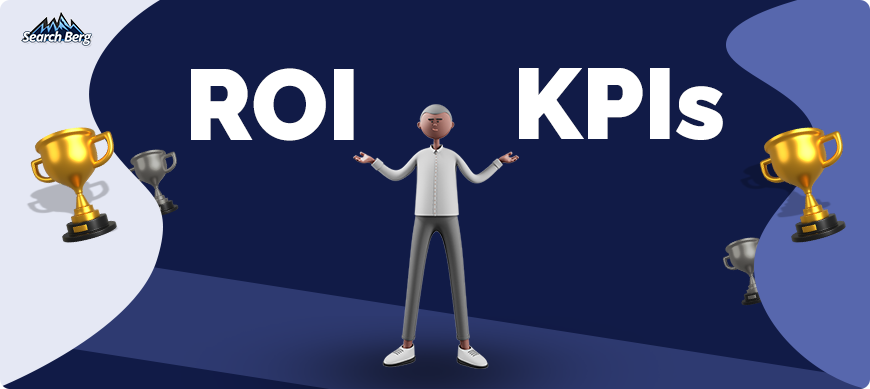
As a small to medium-sized business owner, you’re accustomed to wearing many hats: operations, finance, and now, digital marketing.
You’ve invested time, energy, and resources into online campaigns, but how do you really know if they’re paying off? The answer is simple: by understanding your ROI and KPIs.
Let’s look at it this way. Imagine throwing a grand party and forgetting to send out invites. Or baking a delicious cake but never tasting it.
Failing to gauge the impact of your digital marketing efforts is somewhat similar. It’s like setting up dominos in a meticulously crafted pattern but never really giving the first one a nudge to see the cascade.
Frustrating, isn’t it?
We’re here to turn this frustration into clarity.
Join us as we help you master the art of measuring ROI and KPIs in digital marketing. By the end of this guide, you’ll have a good understanding of how to measure the success of your digital campaigns and amplify their impact. Let’s begin!
1. ROI & KPIs: The Basics
Like any realm of business, digital marketing is riddled with acronyms. You’ve probably heard whispers of “ROI” and “KPIs” being bandied about. But what exactly are they, and why do they carry such weight in the landscape of online marketing? Let’s break it down.
1.1. Return on Investment (ROI)
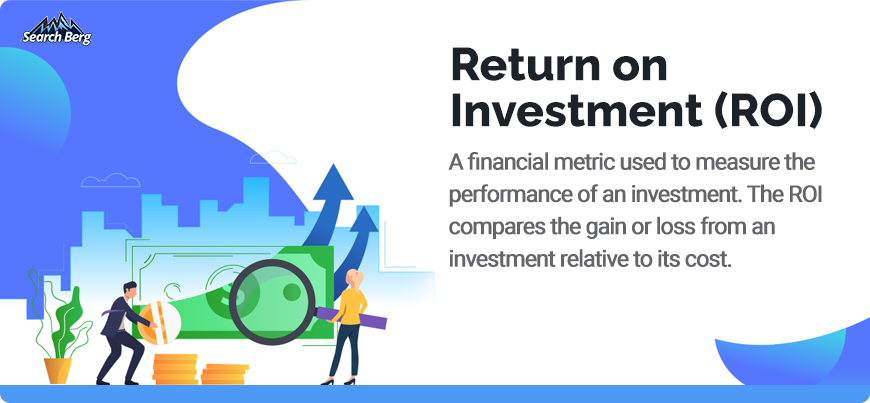
ROI, return on investment, is one of the most venerable metrics in the world of business and finance. You’ll also hear this metric any time someone talks about digital marketing solutions.
It’s a simple yet profound measure designed to determine the profitability of any investment. In the context of digital marketing, it’s the magnifying glass that lets you closely examine the financial effectiveness of your campaigns.
The Essence of ROI: Imagine planting a seed in your garden. The return on investment is analogous to understanding how much fruit that seed yields compared to the effort and resources you invested in nurturing it.
If you’re getting baskets full of fruit from a single seed, it’s a worthy investment. In the world of digital marketing, if your campaigns generate significant revenue relative to the money you poured into them, then your ROI is robust.
The Math Behind It: ROI is computed using a straightforward formula:
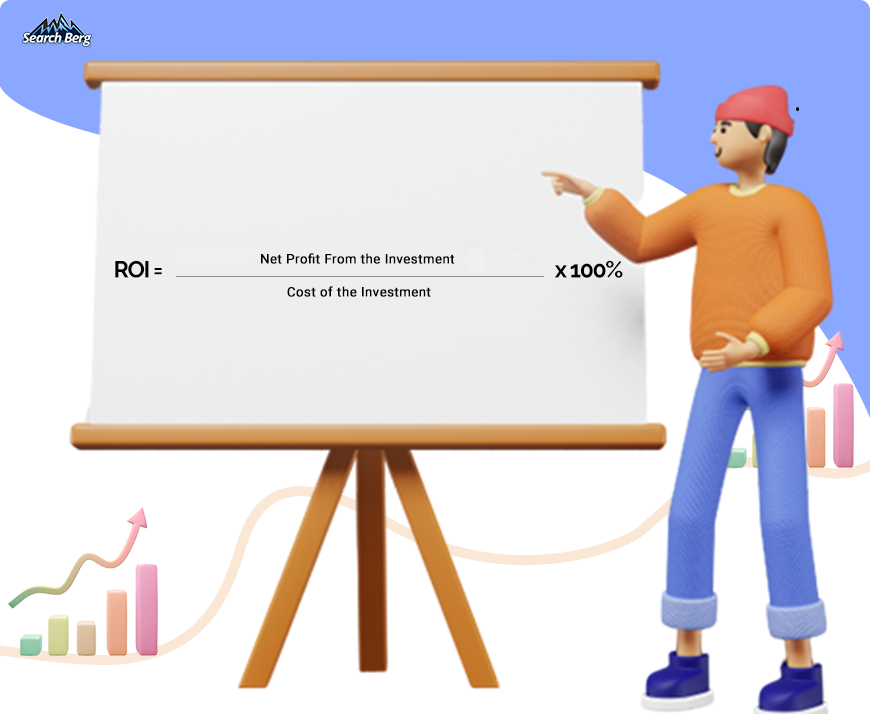
Where:
- Net Profit from the Investment refers to the amount of money earned from the investment minus the cost of the investment.
- Cost of the Investment refers to the amount of money spent to make the investment.
The result is expressed as a percentage. If the ROI is positive, it means the investment gained more than it cost. Conversely, a negative ROI indicates a loss.
For example, if you invest $500 in a digital ad campaign and it generates $1500 in sales, the net profit is $1000 ($1500 – $500). Thus, your ROI would be:
ROI = (1000 ÷ 500) x 100% = 200%
This means you made twice the amount you invested.
Why ROI is Critical in Digital Marketing:
- Accountability & Justification: With tight budgets and the pressure to deliver, every dollar you spend on search engine optimization (SEO) services must be accounted for.
ROI helps justify marketing spends to stakeholders by showcasing tangible results.
- Strategic Decision Making: ROI acts as a compass; it guides you on where to invest more and where to cut back.
High ROI campaigns might warrant more resources. Low ROI initiatives may need re-evaluation or optimization.
- Comparative Analysis: ROI allows you to compare the effectiveness of different marketing channels side by side.
For instance, are your email marketing efforts yielding better returns than your social media ads? ROI will provide a clear answer.
Challenges and Considerations:
- Intangible Returns: Every return can’t be easily quantified. Brand recognition, customer loyalty, and market reputation are invaluable, yet they may not immediately translate into dollars and cents.
It’s important to consider both tangible and intangible returns when evaluating ROI.
- Long-Term Perspective: Some campaigns, especially those focused on brand building or market penetration, may not yield immediate returns. They’re investments for the long haul; their ROI may only be evident over an extended period.
1.2. Key Performance Indicators (KPIs)
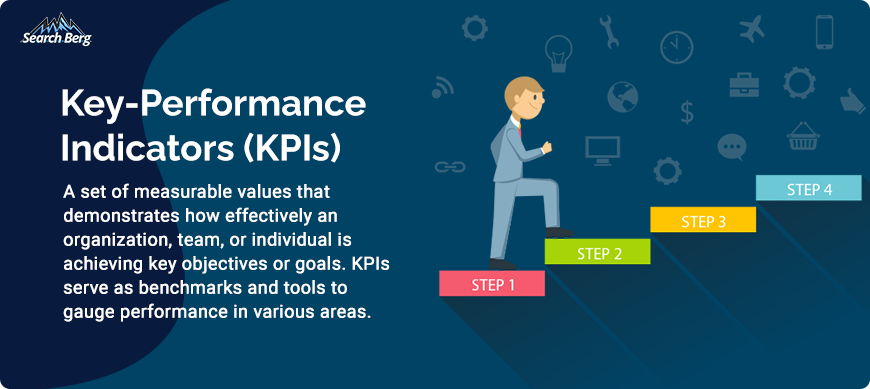
KPIs, key performance indicators, serve as the North Star. They provide direction, offer clarity, and help marketers navigate the complex pathways of online campaigns.
But what exactly are they? And why are they pivotal to a marketer’s toolkit?
The Essence of KPIs: If you keep asking yourself the all-too-familiar question, “What is KPI in marketing?”, you’re at the right place.
KPIs are quantifiable metrics that help businesses assess their performance in relation to their objectives. They are, in essence, the milestones on the roadmap of your digital journey.
The beauty of KPIs lies in their specificity. While there are myriad metrics available, they’re not key performance indicators. KPIs are chosen based on what’s most crucial for your business goals.
- For an eCommerce site, a KPI might be the ‘conversion rate’ or ‘average order value.’
- For a content-driven site, ‘time spent on site’ or ‘bounce rate’ might be more pertinent.
Why KPIs Are an Indispensable Part of Digital Marketing Solutions:
- Focused Strategy: Use clear KPIs to align your team’s efforts toward common goals. This is a great way to ensure everyone’s pushing in the same direction.
- Optimization: KPIs allow for continuous monitoring. If a campaign isn’t meeting its intended KPI, tweaks and adjustments can be made on the fly.
- Resource Allocation: By understanding which initiatives meet their KPIs and which don’t, you can better allocate budgets and resources.
- Transparent Reporting: KPIs facilitate transparent, straightforward reporting. Stakeholders can easily understand the progress and results of marketing efforts.
Crafting the Right KPIs:
- Relevance: Your KPIs should align with your business goals and objectives. If brand visibility is the goal, then “social media shares” or “page views” might be pertinent KPIs.
- Quantifiable: Effective KPIs are measurable. Avoid vague KPIs like “enhance customer satisfaction” and lean toward specific ones like “increase customer review ratings by 15%.”
- Actionable: A KPI should provide insights that can guide action. If “newsletter sign-ups” is a KPI, and it’s underperforming, strategies like revising the sign-up incentive can be deployed.
Challenges and Considerations:
- Overemphasis on Vanity Metrics:It’s easy to get swayed by impressive numbers like “total site visits” or “social media followers.” However, if these don’t correlate with concrete business outcomes, they may be nothing more than mere vanity metrics.
- Changing Dynamics:The digital realm is ever-evolving. A critical KPI today may be irrelevant tomorrow. Closely and consistently review your KPIs to ensure they align with your evolving goals. This step is especially important for search engine optimizationgoals.
1.3. Is ROI a KPI?
Not quite.
Think of ROI as the grand finale of a gripping novel; it reveals the ultimate fate of our protagonist: your business.
It’s the denouement of every plot twist, character arc, and cliffhanger. ROI paints the complete picture of your investment’s performance over time. It’s the long-term narrative that gives context to your entire marketing tale.
KPIs, however, are the exciting chapters of this novel. They set the pace, add depth to characters, and lay out mini climaxes.
While ROI provides the overarching plotline, KPIs add rich texture and nuance, chapter by chapter.
ROI is more long-term; KPIs help measure short-term performance. They’re part of the same game but distinct metrics.
2. Which Metrics Should I Use to Measure ROI in Marketing?
Sure, ROI (return on investment) is the finished masterpiece we’re all aiming for. But to truly grasp its intricacies, one must become fluent in the language of other metrics as well.
Each metric is like a unique tool. Some are your standard screwdrivers; others are more specialized like that oddly-shaped IKEA key.
To craft a masterpiece, you must know when and how to use each tool in your digital toolkit. Let’s walk you through these intricacies one by one.
2.1. Conversion Rate

The conversion rate is the heartbeat of your digital efforts; it indicates how well you’re turning passive visitors into active participants.
It’s calculated by dividing the number of desired actions (like purchases, sign-ups, or downloads) by the total number of visitors. Then multiply by 100 to get a percentage.
If you’re seeing a high conversion rate, give yourself a pat on the back! This means your content, user experience, and calls-to-action (CTAs) are resonating with your target audience.
On the flip side, a low conversion rate could signal a disconnect somewhere along the user journey.
How does all this tie in with the ROI? The conversion rate directly influences it; a higher rate typically means you’re getting more value (sales, leads, subscribers) for your marketing buck.
When you optimize for better conversions, you’re essentially squeezing more juice out of your existing traffic.
Want to enjoy a higher conversion rate? Turn to professional SEO services. By leveraging advanced optimization techniques, tailored keyword strategies, and meticulous site audits, you’ll develop a robust online presence.
Expert SEO service providers will dive deep into your site’s structure, content, and backlink profile; they’ll make adjustments where necessary and implement practices that drive organic traffic. And as we all know, more targeted traffic often translates to more conversions!
2.2. Cost Per Lead (CPL)
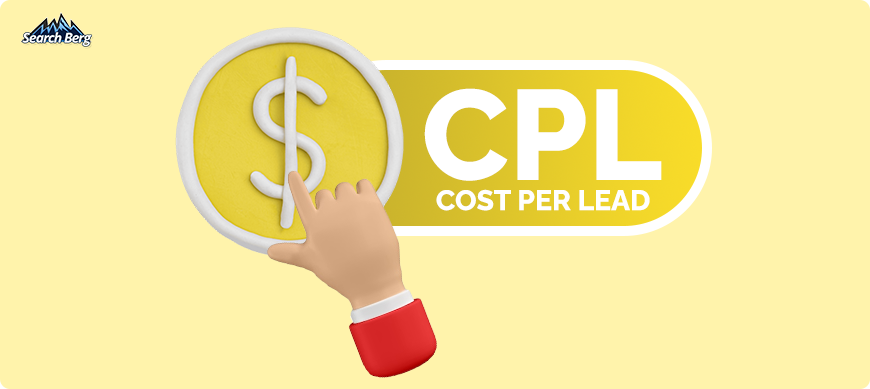
The cost per lead (CPL) throws light on the financial efficiency of your lead generation campaigns. It tells you how much you’re spending to get a potential customer’s interest.
Calculate CPL by dividing the total cost of a campaign by the number of leads it generates.
This a pivotal metric for any business keeping a close eye on their marketing budget. A lower CPL suggests that your marketing efforts are cost-effective; a higher one may indicate some wastage or inefficiencies.
The direct correlation to ROI here is evident: if you’re spending less to acquire a lead, your return on that investment increases. By minimizing CPL, you maximize ROI.
2.3. Cost Per Acquisition (CPA)

Cost per acquisition (CPA) dives deeper into the sales funnel than CPL. While CPL gauges the cost of generating interest, CPA assesses the cost of converting that interest into a sale or a sign-up.
Calculated by dividing the total campaign cost by the number of acquisitions (sales/sign-ups), CPA gives a clear picture of the cost-effectiveness of your conversion strategies.
A lower CPA is always the goal; it means you’re spending less to convert a lead into a customer.
When it comes to ROI, CPA plays a starring role. If your CPA is high, even a significant sales volume might not give you a good return. Conversely, a low CPA means you’re getting a higher return relative to your investment.
Closely monitor and optimize your CPA to achieve the healthiest ROI possible. And if you want to maintain a low CPA, hire SEO services.
2.4. Lead Close Rate

The lead close rate is like a reality check for businesses; it reminds us that every lead won’t turn into a sale (as much as we want it to).
It’s the percentage of leads that turn into actual customers. To determine this, divide the number of closed sales by the total number of leads and then multiply by 100.
A higher ratio tells you that your sales team is effectively converting leads; a lower ratio might hint at potential bottlenecks in the sales process or the quality of leads.
This ratio is a critical player when it comes to ROI. More conversions from leads directly amplify your returns. If you invest in generating 100 leads and close 10 versus 20, the latter scenario obviously gives you a better ROI, all other things being equal.
2.5. Customer Lifetime Value (CLV)

Customer lifetime value (CLV) is the golden metric in the world of digital marketing solutions. It signifies the total revenue a business can reasonably expect from a single customer account. It contemplates a customer’s revenue value and compares that to the company’s predicted customer lifespan.
Businesses ideally want to maximize this value and ensure customers continue to purchase over time. CLV gives depth to ROI calculations by highlighting the long-term value of gaining and retaining customers.
A high CLV means that customers continue to buy from you (which can offset higher initial acquisition costs). Some campaigns might have a higher upfront cost or CPA. However, if they bring in customers with a high CLV, the ROI can be significantly positive over time.
SEO services should be your helping hand here. They’ll ensure your online content and brand messaging align with customer needs and search intent.
By providing relevant content, user-friendly site navigation, and a seamless user experience, SEO paves the way for customer loyalty. And as loyalty grows, so will your CLV!
Hire SEO services with care and consideration. Instead of partnering with just about anyone, turn to an experienced, well-reviewed, and expert SEO service provider you can trust.
2.6. Return on Advertising Spend (ROAS)

ROAS zooms in on the effectiveness of specific advertising campaigns. It tells businesses how much revenue they’re generating for every dollar spent on advertising.
The calculation is pretty straightforward: divide the revenue from ad campaigns by the cost of those ad campaigns. For instance, an ROAS of 5 means you’re generating $5 for every $1 you spend on advertising.
This metric acts as a magnifying glass on your ad spend’s efficacy.
In the context of ROI, ROAS is a subset, focusing specifically on advertising spend rather than the entirety of your investment. A high ROAS contributes positively to your overall ROI because it means your advertising dollars are working hard and bringing in substantial revenue.
If ROAS is low, it’s a cue to reevaluate and optimize your advertising strategies to boost ROI.
2.7. Click-Through Rate (CTR)

Click-through rate (CTR) serves as a digital pulse check; it gives insights into how compelling your online content, ads, or email campaigns are to your audience.
To calculate CTR, divide the number of clicks an item receives by the number of times it has been displayed (impressions). Then multiply by 100 to get a percentage.
A high CTR means your content is grabbing attention and enticing users to take action (yay!). A low CTR suggests the opposite.
In terms of ROI, CTR can be seen as an early indicator of potential success. If more people click on your ads or content, there’s a higher chance they’ll proceed further down the funnel, i.e., make a purchase, sign up, or take any other desired action.
An improved CTR can lead to better conversion rates, and thus, a more favorable ROI.
2.8. Customer Acquisition Cost (CAC)

CAC puts a price tag on each new customer you gain; it encompasses all the costs associated with attracting and converting that customer.
It’s derived by dividing the total costs associated with acquisition (ad spend, marketing salaries, tools, etc.) by the total number of new customers acquired during a particular period.
A lower CAC is the dream; it means you’re acquiring customers without burning a hole in your pocket. Smart digital marketing solutions can help you maintain a low CAC.
On the flip side, a high CAC should ring some alarm bells; it indicates that you’re spending too much without seeing the desired returns.
CAC plays a central role in the realm of ROI. The balance between what you spend (CAC) and what you earn from a customer (often weighed against CLV) provides a clear picture of your investment’s true return.
If you’re spending more to acquire a customer than what they’re bringing in value, your ROI will be in the red. But if your CAC is significantly lower than the revenue these customers generate, then you’re looking at a healthy ROI.
3. How to MeasureYour Digital Marketing Return on Investment (ROI)
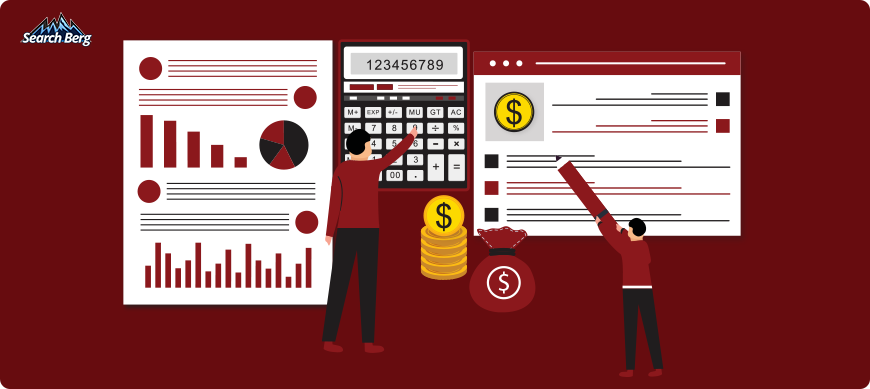
Understanding ROI isn’t just about crunching numbers. It’s a strategic endeavor that can help businesses refocus their efforts and drive better outcomes.
Use these strategies to chart your course to ROI clarity:
3.1. Define Clear Objectives
Every great journey starts with a destination in mind. When it comes to digital marketing, your objectives are these destinations. They give direction to your strategies, determine which metrics matter most, and ultimately help you gauge your success.
Without clear objectives, you’re navigating blindfolded.
When defining these objectives, make sure they align with your broader business goals, are specific, and are measurable. The more precise you are, the clearer your path to achieving and measuring your ROI.
Here’s a table breaking down some common digital marketing objectives:
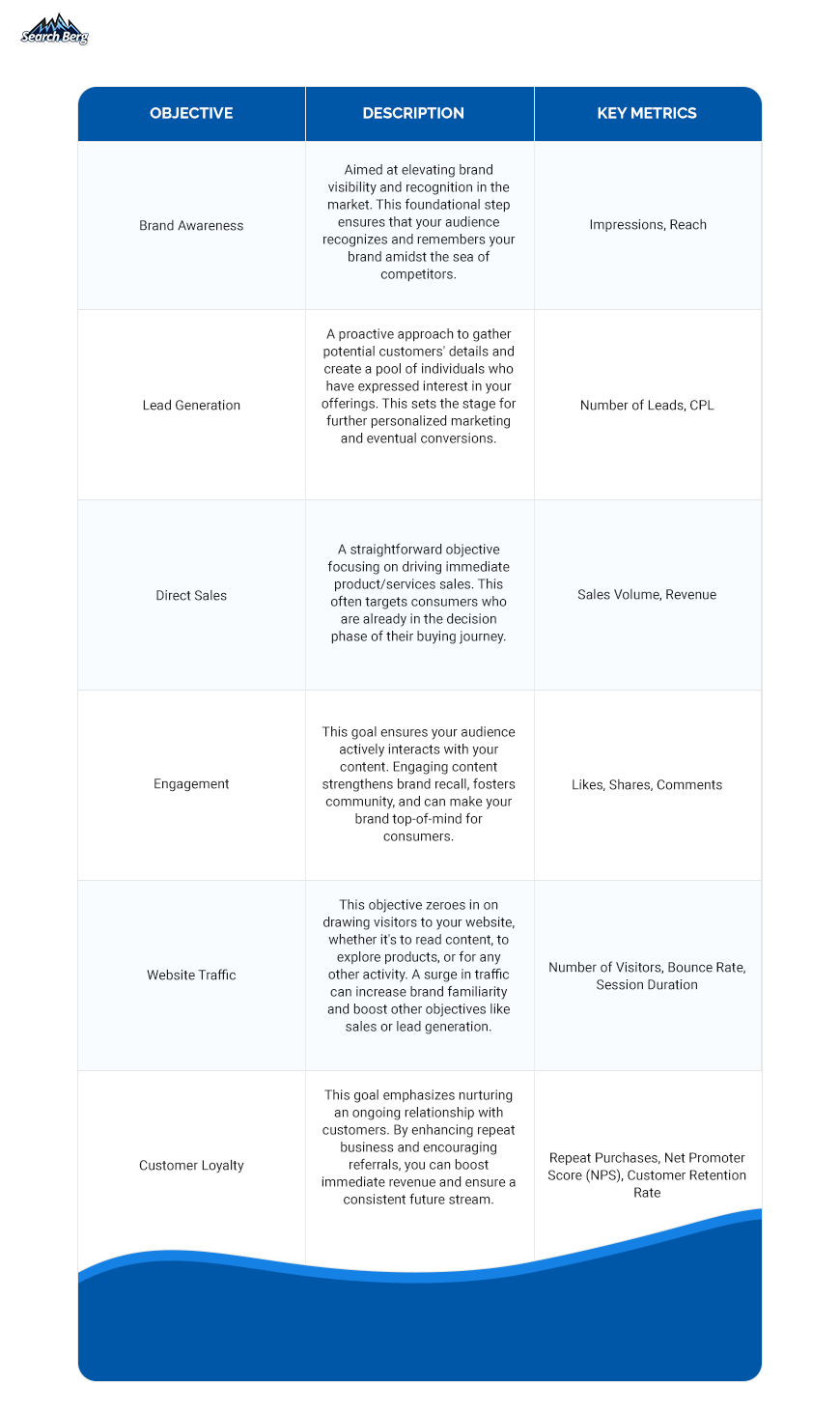
Let’s say you’re launching a new product, and your primary objective is brand awareness. With this objective, your primary focus might be on metrics like impressions and reach. You’d invest in campaigns that amplify visibility, e.g., display ads or influencer partnerships.
When measuring ROI in marketing, instead of just looking at immediate sales, you’d also weigh the long-term value of heightened brand recognition (which can lead to increased sales in the future).
3.2. Calculate Your Total Investment
Every campaign entails a series of interconnected costs. It’s important to consider all the tangibles and intangibles that fuel your digital marketing engine.
From the costs of tools and software to the human capital invested in strategy and execution, every element plays its part. By developing a clear and comprehensive understanding of your total investment, you’ll set the stage for a more accurate ROI calculation.
Here’s a more detailed breakdown of the potential costs associated with digital marketing:
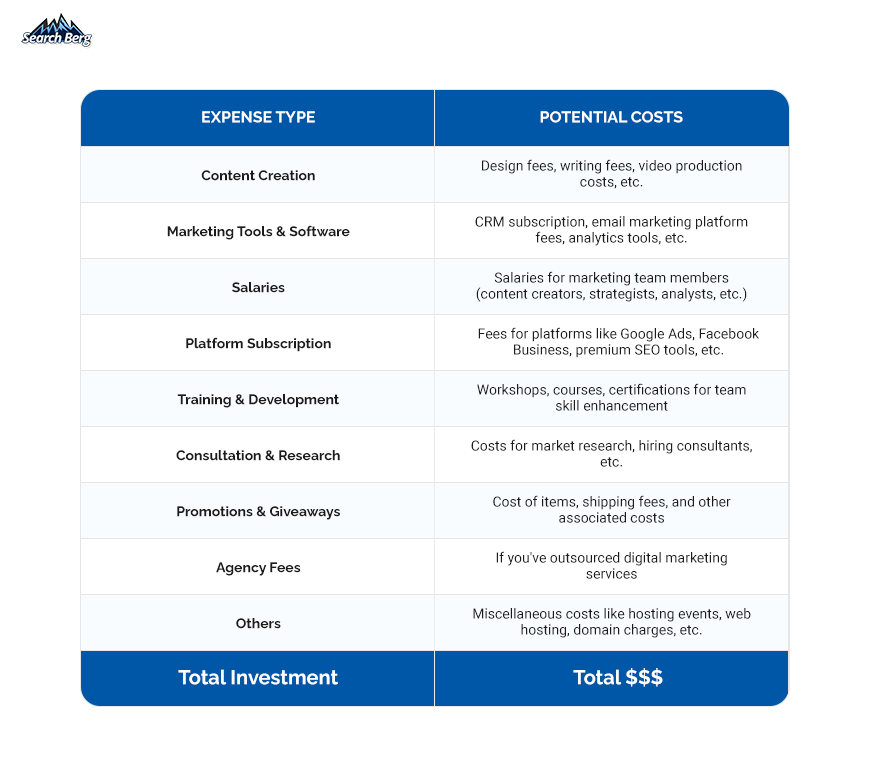
By categorizing and quantifying each of these expenditures, businesses ensure they have a transparent and comprehensive view of their total investment, allowing for a more informed analysis of ROI in marketing.
3.3. Track Relevant Revenue
Calculate the revenue generated from your digital marketing endeavors. This could come from direct sales, leads that eventually convert, or other revenue streams specific to your business model.
3.4. Calculate Your ROI
Use the ROI formula to calculate your ROI.
3.5. Analyze and Interpret
A positive ROI indicates your investment is paying off; a negative ROI suggests the opposite.
But don’t just take these numbers at face value. Dive deeper. Perhaps one campaign has a higher ROI than another. Or maybe certain channels consistently outperform.
These insights will guide future strategies.
3.6. Adjust and Iterate
The culmination of all your digital marketing efforts and analyses boils down to this: what did you learn, and how will you apply that knowledge moving forward?
Stagnation quite simply isn’t an option. With changing algorithms, emerging trends, and evolving consumer behaviors, you must adapt your strategies based on the insights you’ve gleaned.
Once you determine the ROI of your current campaigns and delve deep into the associated metrics, certain patterns will emerge. These insights are gold mines; they offer clear pathways on where to ramp up efforts and where to recalibrate.
But it’s not just about taking these insights at face value. It’s about experimenting with them. For instance, if video content showed a promising ROI, consider exploring different video formats or topics. If a specific keyword drove high traffic, think about related keywords or delve into long-tail keyword opportunities.
Always be open to testing. A/B tests, where you present two versions of a campaign to see which one performs better, can be invaluable. They offer tangible data on what your audience prefers, down to minute details like button colors, call-to-action phrases, or image placements.
Lastly, remember that while past performance is indicative, it’s not absolute. Consumer behaviors shift, new platforms emerge, and industry standards change.
While you should act on the insights you gather, you must also keep a pulse on the broader digital ecosystem. This way, you’re not just reacting to past data but proactively positioning yourself for future success.
4. How to Define Digital Marketing KPIs
Ah, KPIs. They’re like the breadcrumbs Hansel and Gretel left behind. KPIs guide us through the dense digital forest and ensure we’re on the right path to that sweet (and profitable) gingerbread house.
But unlike our fairy tale duo, we’re not looking to backtrack; we’re in it for the onward journey! By defining the right KPIs, we can avoid getting sidetracked by wicked witches or misleading metrics.
How can you select KPIs that’ll lead you to the digital marketing castle you’ve always dreamt of? Let’s show you the way.
4.1. Align with Business Goals
Every business has distinct objectives (regardless of its size or industry). These could range from scaling sales and capturing a larger market share to fostering customer loyalty or enhancing brand visibility.
And while the digital landscape offers a myriad of metrics to track and analyze, only a handful will be pertinent to your specific objectives.
Let’s say your primary business goal for the quarter is to increase product sales. Your KPIs should directly relate to sales metrics. This could involve tracking online sales conversion rates, average order values, or shopping cart abandonment rates.
On the other hand, if your goal is brand awareness, then metrics like website visits, page views, and social media impressions become more critical.
Aligning KPIs with business goals does more than just streamline your tracking efforts. It ensures that every digital marketing endeavor you undertake has a defined purpose.
It eliminates ambiguity, keeps your team focused, and ensures that your resources (both time and money) are invested in endeavors that directly contribute to your business’s larger objectives.
This alignment also facilitates clearer communication with stakeholders. When everyone understands which KPIs are being prioritized and why, it fosters a sense of collective purpose.
Teams can work collaboratively, strategies can be adjusted in real time based on performance against these KPIs, and success can be celebrated in the context of tangible contributions to the business’s goals.
Aligning KPIs with business goals isn’t just a strategic move; it’s foundational. It ensures that the digital marketing machine functions as an integrated part of the larger business ecosystem.
4.2. Be Specific

source: https://phdcomics.com/comics/archive.php?comicid=1634
When setting KPIs, a broad approach can lead to confusion and a lack of direction.
Vague goals can be the Achilles’ heel of even the most well-intentioned digital marketing strategy.
The solution? Precision and specificity.
When you set a KPI like “increase website traffic,” immediate questions arise:
- By how much?
- Over what time frame?
- Through which channels?
A broad goal like this is extremely difficult to measure. It also lacks the direction needed to devise an effective strategy.
Instead, consider a more specific KPI like “boost organic website traffic by 15% over the next quarter.”
This KPI is quantifiable. It also offers clear direction for your SEO and content teams. They now have a tangible target to work toward! Strategies can be crafted to achieve this precise objective.
Being specific with your KPIs has several benefits:
- Clarity of Purpose: Specific KPIs provide teams with a clear understanding of what’s expected. Ambiguity is eliminated.
- Better Resource Allocation: When you know exactly what you’re aiming for, you can allocate resources more effectively.
For instance, knowing you want to boost organic traffic might mean investing more in SEO tools or expertise.
- Easier Measurement: A specific KPI in marketing is inherently more measurable. At the end of the quarter, you’ll know unequivocally whether you achieved that 15% boost in organic traffic.
- Motivation: There’s something inherently motivating about having a specific target. Teams can rally around it, track their progress, and celebrate when it’s achieved!
4.3. Ensure They’re Measurable
If you can’t measure it, you might as well not be doing it. The essence of KPIs is rooted in their measurability. It’s the “performance indicator” aspect that demands quantification.
By ensuring that a KPI is measurable, you’re guaranteeing that it can be tracked, analyzed, and used as a genuine barometer for success.
Imagine setting a KPI like “enhance brand image.” While this is a noble aspiration, it’s nebulous.
How do you know when your brand image is enhanced? What metrics would you use to evaluate this? Without concrete data to back this claim, it becomes subjective and open to interpretation.
In contrast, a KPI like “increase brand mentions on social media by 10% in the next month” is specific and inherently measurable. At the end of the month, a simple analysis of brand mentions will tell you if you’ve met, exceeded, or fallen short of your target.
4.4. Make Them Achievable
Setting KPIs in marketing can sometimes feel like a balancing act.
On one hand, you want to push the boundaries, aim high, and challenge your team. On the other, you want to avoid setting them up for inevitable disappointment with unrealistic targets.
Making KPIs achievable strikes a harmony between ambition and realism, ensuring that while goals stretch abilities and aspirations, they don’t snap the motivation and morale of the team.
Let’s say you task your digital marketing team with doubling website traffic in a week. Sure, it sounds impressive. But unless you have an extraordinary campaign or event coinciding, this goal is unrealistic.
Setting such lofty targets can lead to demotivation; your team may feel set up for failure from the outset.
5. Measure and Monitor Digital Marketing KPIs Like a Pro

In the hushed confines of a laboratory, a chemist meticulously measures each drop, ensuring that the exact quantity of every chemical is added to the concoction.
A tad too much or a bit too little, and the reaction might not be as expected.
KPIs are eerily similar; you have to measure and monitor each metric with the precision of a seasoned chemist. Too much focus on one KPI, and you might miss out on an essential reaction happening elsewhere. Too little attention and the desired results may remain elusive.
Now, you don’t need lab goggles or a white coat, but you certainly need the same dedication, attention to detail, and knowledge of how each chemical (read: metric) plays its part in the grand experiment of digital marketing.
5.1. The Dashboard Delight
Before you embark on the exhilarating journey of data exploration, make sure you have a dashboard that’s as intuitive as it is informative.
This powerhouse tool should be designed to consolidate the vast streams of data pouring in from various channels. It must offer a birds-eye view of all the metrics you deem essential (while also allowing the option to delve deeper when needed).
One standout in this space is Google Analytics. This power-packed platform offers comprehensive insights into your web traffic and user behavior.
But its true beauty lies in customization. Users can tailor their dashboards to their specific needs and highlight metrics like real-time visitors, bounce rate, conversion paths, and more.
The ability to set up custom alerts means you’re always in the loop (even when you’re not logged in).
The real delight of having a dedicated dashboard, however, is the clarity it provides. Instead of juggling multiple platforms or sifting through spreadsheets, you have a single, unified source of truth.
This is an excellent way to streamline your workflow and ensure your decision-making is based on accurate, up-to-date information.
At Search Berg, we use our own trusty dashboard! We ensure that the metrics most vital to your objectives are front and center. Whether you’re focused on organic traffic trends, user behavior analytics, or conversion stats, every piece of data is laid out for easy interpretation.
There’s also an emphasis on real-time data. Our dashboard ensures you have access to the most up-to-date insights for quicker decision-making.
5.2. Regular Rendezvous with Reports
Letting data accumulate without periodic reviews is akin to letting mail pile up; important insights might get lost in the stack.
Engage with your reports regularly to ensure that you’re always on top of your game. This is a great way to not just understand but master the rhythms, ebbs, and flows of your marketing endeavors.
Frequent check-ins with your reports have multiple benefits. First, they allow for timely interventions. If a campaign isn’t delivering as expected or if there’s an unexpected surge in traffic (hooray!), you become immediately aware and can adjust your strategy or allocate resources accordingly.
It’s the difference between steering a ship continuously as the winds change and suddenly realizing you’re way off course.
Secondly, consistency in reviewing reports fosters a deeper understanding of your audience. Over time, patterns emerge. You’ll start to note the days your audience is most active, the content that resonates, and the marketing channels that offer the best ROI.
It’s like getting to know a friend better with each conversation; you learn their likes, dislikes, habits, and quirks. And in marketing, understanding your audience is half the battle won.
Lastly, regular encounters with your reports promote a culture of accountability and transparency within teams. When you’re habitually pulling up data, discussing results, and making strategy tweaks, it reinforces the importance of every team member’s contribution to the collective goal.
It’s a reminder that every thread counts in the grand tapestry of digital marketing solutions.
5.3. Dive Deep with Segmentation
Surface-level figures often give a general sense of direction, but to truly understand the currents and depths, one must dive deeper.
This is where segmentation enters the picture. It offers a detailed, granular view of your data. It’s kind of like using a magnifying glass on a detailed piece of art!
Segmentation is essentially the process of breaking down your larger audience into smaller, more defined categories based on shared characteristics. Think of it as separating your audience into various rooms based on interests, behavior, or demographics.
By doing so, you’re not just talking to the crowd; you’re engaging in individual conversations, understanding specific needs, and grasping distinct preferences.
Let’s say you’ve launched an email marketing campaign. A surface-level analysis might tell you the open rate and click-through rate. But by employing segmentation, you can see which age groups were more likely to open the email, or which geographical locations showed higher engagement.
Suddenly, you’re not just aware of your campaign’s performance; you’re enlightened about who it appeals to and where.
The power of segmentation is transformative. It helps marketers ensure resources and efforts are channeled in the most effective ways. Instead of casting a broad net, you’re using a refined approach, targeting specific segments with personalized content and campaigns, and reaping stellar results.
What results are we talking here? Higher engagement, better conversion rates, and an enhanced understanding of your audience.
5.4. Alerts and Alarms
Staying continuously glued to your digital marketing metrics might sound ideal, but in reality, it’s neither practical nor efficient.
Yet, missing out on crucial data points or sudden changes can be detrimental to a campaign’s performance.
This is where the magic of alerts and alarms comes to the rescue!
Setting up alerts and alarms is like having a diligent assistant who never sleeps. They constantly monitor your data and immediately notify you of significant changes or anomalies.
Whether it’s a sudden drop in website traffic, a spike in conversion rates, or a decline in ad performance, you’ll know exactly what’s happening. These notifications ensure you’re always in the know (even when you’re not actively looking).
But it’s not just about catching potential issues; it’s also about seizing exciting opportunities.
Let’s say a piece of content you’ve created starts gaining unexpected traction. An alert can notify you of this trend in real-time, allowing you to capitalize on its popularity, perhaps by promoting it more aggressively or creating follow-up content.
These alerts and alarms also instill a sense of security and control. You can rest easy, knowing that if something significant occurs (good or bad), you’ll be the first to know. This proactive approach ensures you’re ready to pivot, adapt, or celebrate.
Oh, and let’s not forget that alerts and alarms will also help you stay on top of your search engine optimization game! If you’ve hired professional SEO services, you’ll be able to track all the great work they’re doing. You’ll also become aware of any lapses in their strategy; nothing will slip through the cracks unnoticed.
5.5. Reflection and Refinement
In the whirlwind of executing digital marketing solutions, it’s easy to become consumed by day-to-day activities. However, periodically pausing to reflect on performance and refining strategies is paramount to sustained success.
Step back and assess the bigger picture. This is the moment you sit down with your wealth of data and ask the vital questions:
- What worked?
- What didn’t?
- Were the set goals achieved?
- Were there any unexpected outcomes?
This exercise isn’t merely about celebrating success (though that’s essential, too); it’s primarily about identifying areas of improvement.
Following reflection, it’s time for refinement. Once you’ve identified gaps, inefficiencies, or missed opportunities, the next logical step is to tweak and optimize. This could mean altering content strategies, revising ad spends, targeting a different audience segment, or even overhauling an entire campaign approach.
Instead of shooting in the dark, hire SEO services. SEO experts will help you make the right (read: smart) changes.
The iterative process of reflection and refinement ensures that your digital marketing strategy remains dynamic and adaptable. Consumer preferences evolve, markets change, and new trends emerge. By integrating regular periods of introspection, you’ll keep your approach fluid, not static.
Embracing this cycle also promotes a culture of continuous learning. Every campaign (successful or not) becomes a lesson. Over time, this attitude improves efficiency and outcomes. You’ll become adept at viewing challenges as opportunities to learn, grow, and come back even stronger!
Search Berg: Fuel for Your ROI and KPI Engine!
By now, you should have a crystal-clear understanding of the importance of measuring ROI and KPIs in digital marketing. You should also have answers to the following questions:
- What is KPI in marketing?
- What is ROI in marketing?
- Is ROI a KPI?
The next step? Putting your knowledge to good use! By measuring your digital marketing ROI and tracking the right KPIs, you’ll develop a complete picture of how your business is doing. Are your strategies working? Are they failing? What are the insights telling you?
At Search Berg, we take the reins for you. We provide digital marketing services to help you enjoy high rankings, impressive traffic, and stellar growth. And if ROI and KPIs keep confusing you, we’ll also help you track and measure these metrics. Hire SEO services today. We’ll start off with a free consultation to help you understand how our digital marketing solutions can benefit you. Let’s begin!













